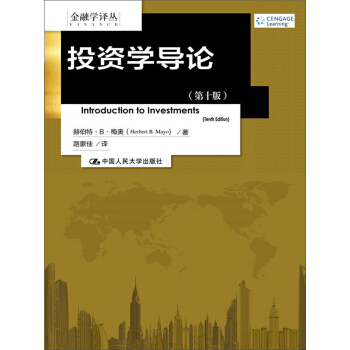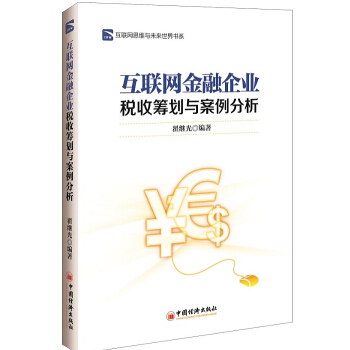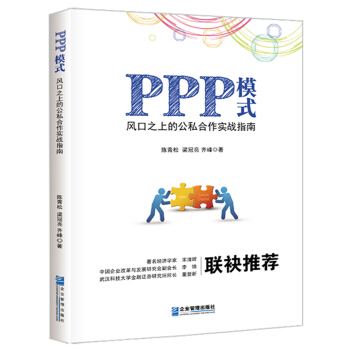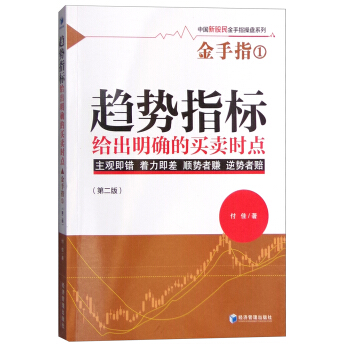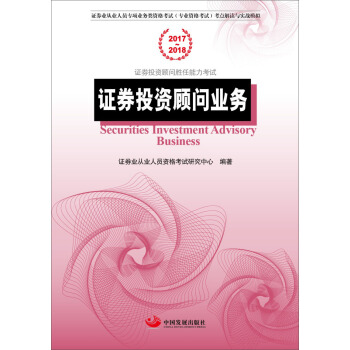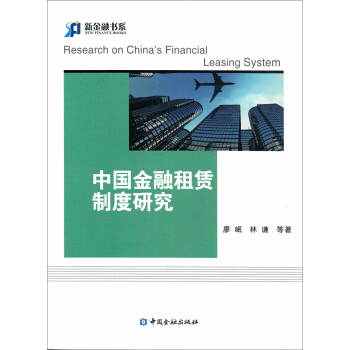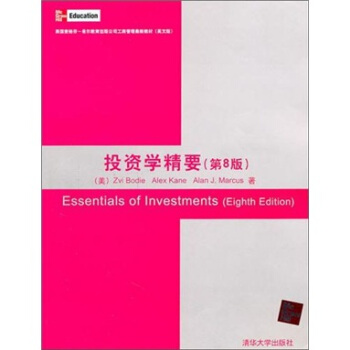

具体描述
内容简介
《投资学精要(第8版)(英文版)》由美国三位著名的金融学教授博迪、凯恩、马库斯撰写,是美国商学院和管理学院的教材,在世界各国都有很大的影响,被广泛采用。本书详细讲解了投资领域中的风险组织理论、资本资产定价模型、套利定价理论、市场有效性、证券评估、衍生证券等重要内容。本书阐述详尽,结构清楚,设计独特,语言生动活泼,学生易于理解,内容上注重理论与实践的结合。
《投资学精要(第8版)(英文版)》适合作为金融专业高年级本科生、研究生、MBA教材,也可供金融领域的研究人员,从业人员参考。
目录
第1部分 投资要素第1章 投资:背景与要点
第2章 资产类别与金融工具
第3章 证券市场
第4章 共同基金和其他投资公司
第2部分 投资组合理论
第5章 风险与回报:历史与序幕
第6章 有效的分散化
第7章 资本资产定价模型与套利定价理论
第8章 有效市场假说
第9章 行为金融与技术分析
第3部分 债务证券
第10章 债券的价格与收益
第11章 债券资产组合的管理
第4部分 证券分析
第12章 宏观经济分析与行业分析
第13章 股权估价
第14章 财务报表分析
第5部分 衍生市场
第15章 期权市场
第16章 期权定价
第17章 期货市场与风险管理
第6部分 积极的资产组合管理
第19章 全球化与国际投资
第21章 税收、通货膨胀与投资战略
附录A
附录B
精彩书摘
2.2 The Bond MarketThe bond market is composed of longer-term borrowing or debt instruments than those that trade in the money market. This market includes Treasury notes and bonds, corporate bonds, municipal bonds, mortgage securities, and federal agency debt.
These instruments are sometimes said to comprise the fixed-income capital market,because most of them promise either a fixed stream of income or stream of income that is determined according to a specified formula. In practice, these formulas can result in a flow of income that is far from fixed. Therefore, the term “fixed income” is probably not fully appropriate. It is simpler and more straightforward to call these securities either debt instruments or bonds.
Treasurv Notes and Bonds
The U.S. government borrows funds in large part by selling Treasury notes and bonds. T-notes are issued with original maturities ranging up to 10 years, while T-bonds are issued with maturities ranging from 10 to 30 years. Both bonds and notes may be issued in increments of $100, but far more commonly trade in denominations of $1,000. Both bonds and notes make semiannual interest payments called coupon payments, so named because in precomputer days, investors would literally clip a coupon attached to the bond and present it to receive the interest payment.
Figure 2.4 is an excerpt from a listing of Treasury issues in The Wall Street Journal Online.The highlighted bond matures in February 2015. The coupon income or interest paid by the bond is 4% of par value, meaning that for a $1,000 face value bond, $40 in annual interest payments will be made in two semi annulments of $20 each. The numbers to the right of the colon in the bid and ask prices represent units of 1/32 of a point.
The bid price of the highlighted bond is 105 20/32, or 105.625. The asked price is 105 22/32, or 105.6875. Although bonds are typically traded in denominations of $1,000 par value, the prices are quoted as a percentage of par value. Thus, the asked price of 105.6875 should be interpreted as 105.6875% of par or $1,056.875 for the $1,000 par value bond. Similarly, the bond could be sold to a dealer for $1,056.25. The +29 change means the closing price on this day rose 29/32 (as a percentage of par value) from the previous day's closing price. Finally, the yield to maturity on the bond based on the ask price is 3.017%.
The yield to maturity reported in the last column is a measure of the annualized rate of return to an investor who buys the bond and holds it until maturity.lt accounts for both coupon income as well as the difference between the purchase price of the bond and its final value of $1,000 at maturity. We discuss the yield to maturity in detail in Chapter 10.
Inffation-Protected Treasurv Bonds
The best place to start building an investment portfolio is at the least risky end of the spectrum. Around the world, governments of many countries,including the U.S., have issued bonds that are linked to an index of the cost of living in order to provide their citizens with an effective way to hedge inflation risk.
In the United States, inflation-protected Treasury bonds are called TIPS (Treasury Inflation Protected Securities). The principal amount on these bonds is adjusted in proportion to increases in the Consumer Price Index. Therefore, they provide a constant stream of income in real (inflation-adjusted) dollars, and the realinterest rates you eam on these securities are risk-free if you hold them to maturity. An i following the bond's maturity date in Figure 2.4 denotes that the bond is an inflation-indexed TIPS bond, and you will see that the reponed yields on these bonds are lowef than those on surrounding conventional Treasuries. Compare, for example, the reported yield on the January 2015i bond, 1.820%, to the 3.017% yield on the February 2015 bond that precedes it. The yields on TIPS bonds should be inter- preted as real or inflation-adjusted interest rates. We return to TIPS bonds in more detail in Chapter 10.
Federal Agency Debt
Some govemment agencies issue their own securities to finance their activities. These agencies usually are formed for public policy reasons to channel credit to a particular sector of the economy that Congress believes is not receiving adequate credit through normal private sources.
The major mortgage-related agencies are the Federal Home Loan Bank (FHLB), the Federal National Mortgage Association (FNMA, or Fannie Mae), the Government National Mortgage Association (GNMA, or Ginnie Mae), and the Federal Home Loan Mortgage Corporation
(FHLMC, or Freddie Mac).
Although the debt of federal agencies is not explicitly insured by the federal government, it has long been assumed that the government would assist an agency nearing default. Those beliefs were validated when Fannie Mae and Freddie Mac actually encountered severe financial distress in September 2008. With both firms on the brink of insolvency, the government stepped in and put them both into conservatorship, assigned the Federal Housing Finance Agency to run the firms, but did in fact agree to make good on the firm's bonds. (Turn back to Chapter 1 for more discussion of the Fannie and Freddie failures.)
International Bonds
Many firms borrow abroad and many investors buy bonds from foreign issuers. In addition to national capital markets, there is a thriving international capital market, largely centered in London.
A Eurobond is a bond denominated in a currency other than that of the country in which it is issued. For example, a dollar-denominated bond sold in Britain would be called a Euro-dollar bond. Similarly, investors might speak of Euroyen bonds, yen-denominated bonds sold outside Japan. Since the new European currency is called the euro, the term Eurobond may be confusing. It is best to think of them simply as international bonds.
In contrast to bonds that are issued in foreign currencies, many firms issue bonds in foreign countries but in the currency of the investor. For example, a Yankee bond is a dollar-denominated bond sold in the U.S. by a non-U.S. issuer. Similarly, Samurai bonds are yen-denominated bonds sold in Japan by non-Japanese issuers.
Municipal Bonds
Municipal bonds (“mums”) are issued by state and local governments. They are similar to Treasury and corporate bonds, except their interest income is exempt from federal income taxation. The interest income also is exempt from state and local taxation in the issuing state. Capital gains taxes, however, must be paid on mums if the bonds mature or are sold for more than the investor's purchase price.
There are basically two types of murucipal bonds. General obligation bonds are backed by the “full faith and credit” (i.e., the taxing power) of the issuer, while revenue bonds are issued to finance particular projects and are backed either by the revenues from that project or by the municipal agency operating the project. Typicalissuers of revenue bonds are airports, hospitals, and tumpike or port authorities. Revenue bonds are riskier in terms of default than general obligation bonds.
An industrial development bond is a revenue bond that is issued to finance commercial enterprises, such as the construction of a factory that can be operated by a private firm.ln effect, this device gives the firm access to the municipality's ability to borrow at tax-exempt rates, and the federal government limits the amount of these bonds that may be issued.2 Figure 2.5 plots outstanding amounts of industrial revenue bonds as well as general obligation municipal bonds.
Like Treasury bonds, municipal bonds vary widely in maturity. A good deal of the debt issued is in the form of short-term tax anticipation notes that raise funds to pay for expenses before actual collection of taxes. Other municipal debt may be long term and used to fund large capital investments. Maturities range up to 30 years.
The key feature of municipal bonds is their tax-exempt status. Because investors pay neither federal nor state taxes on the interest proceeds, they are willing to accept lower yields on these securities.
……
前言/序言
用户评价
《投资学精要》(第8版)(英文版)这本书,给我最大的触动在于它所展现出的前沿性和实践性。我过去接触过一些投资学的书籍,但很多都停留在理论的层面,或者内容更新得不够及时。而这本第8版,显然是紧跟时代步伐的。我在阅读的过程中,发现书中不仅涵盖了经典的投资理论,还融入了近年来金融市场的一些新发展和新趋势。例如,在讨论投资组合管理时,书中不仅介绍了传统的均值-方差优化,还提及了一些现代的风险管理技术,以及如何利用大数据和量化方法来构建和优化投资组合。我特别欣赏书中对于金融科技(FinTech)和加密货币等新兴领域的探讨,虽然篇幅可能不多,但足以说明作者的视野非常开阔,并且愿意将这些前沿话题纳入到投资学的范畴内进行讨论。此外,书中大量的案例研究,都取材于现实生活中真实的投资案例,有些甚至是最近几年发生的。这让我能够将书本上的理论知识与实际的市场表现联系起来,更好地理解理论的适用性和局限性。这种理论与实践相结合的教学方式,让我在学习过程中充满了成就感,也让我对未来的投资实践充满了信心。
评分拿到《投资学精要》(第8版)(英文版)这本书,我的第一感觉是它非常有分量,不仅是物理上的重量,更是知识上的厚重感。我一直觉得,想要真正理解投资,就必须从最基础、最核心的理论入手,而这本书恰好满足了我的这个需求。它深入浅出地讲解了投资学的基本原理,从最基本的概念,比如风险与回报的关系,到复杂的金融衍生品,应有尽有。让我印象深刻的是,作者在阐述诸如CAPM(资本资产定价模型)等经典理论时,并没有直接抛出公式,而是先通过生动的比喻和逻辑推理,解释了这些模型背后的思想和假设,然后再逐步引出数学表达。这种循序渐进的方式,极大地降低了理解的门槛,让我这种初学者也能轻松跟上思路。此外,书中对各种金融市场工具的介绍也十分详尽,无论是股票、债券,还是期权、期货,都进行了详细的分类和阐述,并分析了它们的风险收益特征和交易机制。我尤其喜欢书中关于行为金融学的章节,它打破了我过去对“理性投资者”的刻板印象,让我认识到人类心理在投资决策中的重要作用,以及这些非理性因素是如何影响市场价格的。这本书就像一个完整的知识体系,将投资学的方方面面有机地串联起来,让我得以在一个宏观的框架下理解各项知识点,从而形成自己的投资理念。
评分《投资学精要》(第8版)(英文版),这本书给我的感觉是,它不仅仅是一本教材,更像是一本投资领域的“圣经”。我一直认为,要成为一名合格的投资者,不仅仅需要掌握金融市场的知识,还需要具备良好的风险管理意识和投资决策能力。这本书恰恰在这些方面给予了我极大的启发。在风险管理的部分,作者详细阐述了不同类型的风险,以及如何通过各种金融工具和策略来对冲和管理这些风险。我尤其对书中关于“ VaR (Value at Risk)”的讲解印象深刻,它让我理解了如何量化和评估投资组合在特定时间内的最大潜在损失。在投资决策方面,书中提供了多种决策框架和模型,比如价值投资、成长投资、指数化投资等,并分析了它们各自的优劣势和适用场景。我还在书中看到了关于“投资心理学”的章节,它揭示了许多投资者在实际操作中容易犯的心理误区,比如羊群效应、过度自信、锚定效应等,并提供了克服这些心理障碍的方法。这些内容让我意识到,投资不仅仅是数字的游戏,更是对人性的深刻洞察。
评分当我第一次翻开《投资学精要》(第8版)(英文版)时,就被它宏大的叙事和严谨的逻辑所吸引。我一直认为,投资学是一门既有深度又有广度的学科,而这本书恰好满足了我的期待。它从宏观的经济环境分析,到微观的资产定价,再到具体的投资组合构建和风险管理,层层递进,条理清晰。我最喜欢的是书中关于“资产定价”部分的讲解,它不仅介绍了诸如CAPM、APT等经典的定价模型,还深入分析了这些模型背后的假设条件,以及在现实世界中可能存在的偏差。作者还通过大量的案例分析,向我们展示了如何在实践中运用这些定价模型来评估资产的内在价值,并发现被低估或高估的投资机会。此外,书中关于“投资组合理论”的阐述也让我受益匪浅。它让我理解了“分散投资”的重要性,以及如何通过构建最优的投资组合来在给定风险水平下最大化预期回报。这些内容让我深刻体会到,投资并非盲目跟风,而是一门需要科学方法和严谨分析的艺术。
评分《投资学精要》(第8版)(英文版),这本书给我的感觉是,它非常注重理论与实践的结合。我一直认为,学习投资学,不能只停留在理论层面,而必须与实际的市场相结合,才能真正发挥作用。这本书在这方面做得非常出色。它不仅详细讲解了各种投资理论和模型,还通过大量的案例分析,向我们展示了如何在实际的投资活动中运用这些理论。例如,在讲解股票估值时,作者不仅介绍了DCF、DDM等传统估值方法,还结合了不同公司的实际财务数据,进行详细的估值分析,并提供了实操的建议。在期权交易部分,它不仅讲解了期权的定价模型,还分析了不同交易策略在不同市场情况下的适用性。更重要的是,书中还包含了对宏观经济环境、行业发展趋势等对投资的影响的分析,这让我能够从更宏观的视角来审视投资机会。这种理论与实践相结合的讲解方式,让我在学习过程中充满了启发,也让我对未来的投资实践充满了信心。
评分《投资学精要》(第8版)(英文版)这本书,对我而言,不仅仅是一本关于投资学的入门读物,更像是一位经验丰富的投资导师。我一直对金融市场充满好奇,但又苦于找不到一个清晰的路径来系统学习。这本书的出现,无疑为我打开了一扇新的大门。我特别欣赏它在讲解一些复杂概念时,所采用的“由浅入深”的方式。例如,在解释“衍生品”时,作者并没有直接抛出复杂的期权定价公式,而是先从期权最基本的买卖双方意图开始,然后逐步引出期权的基本类型、行权价、到期日等要素,最后才介绍Black-Scholes模型等定价方法。这种循序渐进的讲解方式,让我能够一步步地理解这些相对复杂的金融工具。此外,书中还提供了大量的练习题和案例分析,这让我能够将学到的知识运用到实际的练习中,巩固理解。我还在书中看到了关于“投资者行为”的讨论,它让我认识到,人类的心理因素在投资决策中扮演着至关重要的角色,并且了解这些心理 biases 可以帮助我做出更理性的投资决策。
评分当我拿到《投资学精要》(第8版)(英文版)这本书的时候,我就知道我找到了一本值得我深入研读的宝藏。这本书以其清晰的结构和全面的内容,为我构建了一个坚实的投资学知识体系。我一直认为,学习投资学,最重要的就是要理解风险与回报之间的内在联系,而这本书在这方面做得非常到位。它不仅仅是简单地列出风险和回报的定义,而是通过大量的图表和案例,生动地展示了不同金融工具、不同投资策略下的风险回报特征。比如,在讲解股票投资时,它不仅分析了股票的潜在高回报,也详细阐述了股票价格波动的风险、公司经营风险等。在债券投资部分,它则深入剖析了利率风险、信用风险等。让我印象深刻的是,书中对于“投资组合理论”的阐述,它不仅介绍了均值-方差模型,还探讨了如何构建一个能够分散风险、提高收益的有效投资组合。这些内容让我对风险管理和资产配置有了更深刻的理解,也让我明白了为什么“不要把所有的鸡蛋放在同一个篮子里”。
评分这本书,我称之为“投资学的百科全书”,毫不夸张。《投资学精要》(第8版)(英文版)的内容之丰富,让我一度以为它是一套系列的图书。从最基本的金融市场结构,到股票、债券、基金等各类投资工具的详细分析,再到复杂的期权、期货、外汇等衍生品市场,作者都进行了深入浅出的讲解。我最喜欢的是它在介绍每个金融工具时,都会非常细致地分析其内在的风险和收益特征,以及在不同市场环境下的表现。比如,在讲解债券时,它不仅介绍了不同类型的债券,如国债、公司债、市政债等,还深入分析了利率风险、信用风险、流动性风险等,并提供了相应的对冲和管理方法。这种细致入微的讲解,让我能够对每一种投资工具有一个非常全面和深刻的认识,不再是浅尝辄止。而且,这本书的逻辑性非常强,章节之间的过渡自然流畅,仿佛是在构建一座精密的知识体系。当你读完一个章节,就会对下一个章节的内容产生自然的联想,从而形成一个完整的知识闭环。对于想要系统学习投资学的人来说,这本书绝对是一个不二之选。
评分拿到《投资学精要》(第8版)(英文版)这本书,我首先是被它的排版和设计所吸引。虽然是英文原版,但页面的设计非常简洁清晰,重点突出,阅读体验相当不错。我一直对投资学抱有浓厚的兴趣,但过去总是觉得它晦涩难懂,理论性太强。这本书在这一点上做得非常出色,它用非常易于理解的语言,讲解了投资学中一些核心的概念和模型。例如,在介绍有效市场假说时,作者并没有仅仅引用理论,而是通过列举不同程度的有效市场表现,来解释弱式、半强式和强式有效市场之间的区别,并且还引用了一些实证研究来支持这些观点。这种严谨而不失趣味性的讲解方式,让我能够快速地把握核心要义。我尤其欣赏的是,书中在讲解每一个模型或理论时,都会提供相应的数学公式,但同时也会有详细的文字解释,并且会用图表来辅助说明,使得复杂的数学概念变得更加直观。这对于我这种不太擅长数学的学习者来说,简直是福音。它让我感觉到,学习投资学并非遥不可及,而是可以通过系统学习和反复练习来掌握的。
评分这本书的名字叫《投资学精要》(第8版)(英文版),我拿到这本书的时候,内心是既期待又有些忐忑的。作为一个对投资领域充满热情但又刚起步的学习者,我深知理论基础的重要性。这本书的厚度和内容密度,从第一眼看到就让我感受到了它的“精要”二字并非浪得虚名。我翻开第一页,就被其中严谨的逻辑和清晰的结构所吸引。作者在开篇就为我们描绘了投资学宏大的图景,从宏观经济环境对投资的影响,到微观层面各类金融工具的详解,再到资产定价模型和投资组合理论的深入探讨,似乎涵盖了投资学习的每一个关键节点。我尤其欣赏的是,它并没有停留在枯燥的理论堆砌,而是通过大量的案例分析和现实世界的联系,将抽象的概念具象化。例如,在讲解股票估值的部分,作者并没有仅仅罗列DCF、DDM等模型,而是结合了不同行业的实际公司案例,详细解析了如何根据公司特点选择合适的估值方法,以及在实际操作中会遇到的各种挑战和注意事项。这种“学以致用”的导向,让我觉得这本书不仅仅是一本教材,更像是一位经验丰富的导师,循循善诱地引导我一步步走向投资的殿堂。它让我明白,投资并非一场赌博,而是一门需要严谨思考、科学分析和审慎决策的学问。我迫不及待地想要深入其中,去理解那些复杂的公式背后所蕴含的智慧,去掌握那些能够帮助我做出明智投资决策的工具。这本书无疑是我投资学习之旅中一份宝贵的财富,它为我打下了坚实的基础,也点燃了我更深入探索投资世界的决心。
评分在学校买书真心特别贵,所以在京东买书,快而且非常的便宜,非常愉快的购物体验。 《投资学精要(第8版)(英文版)》由美国三位著名的金融学教授博迪、凯恩、马库斯撰写,是美国商学院和管理学院的首选教材,在世界各国都有很大的影响,被广泛采用。本书详细讲解了投资领域中的风险组织理论、资本资产定价模型、套利定价理论、市场有效性、证券评估、衍生证券等重要内容。本书观点权威,阐述详尽,结构清楚,设计独特,语言生动活泼,学生易于理解,内容上注重理论与实践的结合。 《2012年度注册会计师全国统一考试辅导教材:税法》以体现注册会计师考试改革总体目标为宗旨,以读者基本掌握大学会计等相关专业本科以上专业知识为基础,以全面性与系统性、实用性与时效性并重为原则编写而成。《2012年度注册会计师全国统一考试辅导教材:税法》作为指导考生复习和学习之用,不作为注册会计师全国统一考试的指定用书。 《项目融资(第2版)》主要讲述了项目融资的基本概念、项目融资的组织与结构、不同融资模式和运行模式、项目融资的程序、项目融资中存在的风险及其防范方法,讲解了项目融资的担保、项目融资的资金来源,以及项目融资的政治、经济、法律环境等。 财务成本管理 流动比率是相对数,排除了企业规模的影响,更适合同业比较以及本企业不同历史时期的比较。此外,由于流动比率计算简单,因而被广泛应用。 但是,需要提醒注意的是,不存在统一、标准的流动比率数值。不同行业的流动比率,通常有明显差别。营业周期越短的行业,合理的流动比率越低。在过去很长一段时期里,人们认为生产型企业合理的最低流动比率是2。这是因为流动资产中变现能力最差的存货金额约占流动资产总额的一半,剩下的流动性较好的流动资产至少要等于流动负债,才能保证企业最低的短期偿债能力。这种认识一直未能从理论上证明。最近几十年,企业的经营方式和金融环境发生了很大变化,流动比率有下降的趋势,许多成功企业的流动比率都低于2。 如果流动比率相对上年发生较大变动,或与行业平均值出现重大偏离,就应对构成流动比率的流动资产和流动负债的各项目逐一分析,寻找形成差异的原因。为了考察流动资产的变现能力,有时还需要分析其周转率。 流动比率有某些局限,在使用时应注意:流动比率假设全部流动资产都可以变为现金并用于偿债,全部流动负债都需要还清。实际上,有些流动资产的账面金额与变现金额有较大差异,如产成品等;经营性流动资产是企业持续经营所必需的,不能全部用于偿债;经营性应付项目可以滚动存续,无需动用现金全部结清。因此,流动比率是对短期偿债能力的粗略估计。 (2)速动比率。构成流动资产的各项目,流动性差别很大。其中,货币资金、交易性金融资产和各种应收款项等,可以在较短时间内变现,称为速动资产;另外的流动资产,包括存货、预付款项、1年内到期的非流动资产及其他流动资产等,称为非速动资产。 非速动资产的变现金额和时间具有较大的不确定性:①存货的变现速度比应收款项要慢得多;部分存货可能已毁损报废、尚未处理,或者已抵押给某债权人,不能用于偿债;存货估价有多种方法,可能与变现金额相距甚远。②1年内到期的非流动资产和其他流动资产的金额有偶然性,不代表正常的变现能力。因此,将可偿债资产定义为速动资产,计算短期债务的存量比率更可信。
评分还好这一单里基本准备收藏的都没事 省得我退货了
评分经典。。。。。。。。。。。
评分在学校买书真心特别贵,所以在京东买书,快而且非常的便宜,非常愉快的购物体验。 《投资学精要(第8版)(英文版)》由美国三位著名的金融学教授博迪、凯恩、马库斯撰写,是美国商学院和管理学院的首选教材,在世界各国都有很大的影响,被广泛采用。本书详细讲解了投资领域中的风险组织理论、资本资产定价模型、套利定价理论、市场有效性、证券评估、衍生证券等重要内容。本书观点权威,阐述详尽,结构清楚,设计独特,语言生动活泼,学生易于理解,内容上注重理论与实践的结合。 《2012年度注册会计师全国统一考试辅导教材:税法》以体现注册会计师考试改革总体目标为宗旨,以读者基本掌握大学会计等相关专业本科以上专业知识为基础,以全面性与系统性、实用性与时效性并重为原则编写而成。《2012年度注册会计师全国统一考试辅导教材:税法》作为指导考生复习和学习之用,不作为注册会计师全国统一考试的指定用书。 《项目融资(第2版)》主要讲述了项目融资的基本概念、项目融资的组织与结构、不同融资模式和运行模式、项目融资的程序、项目融资中存在的风险及其防范方法,讲解了项目融资的担保、项目融资的资金来源,以及项目融资的政治、经济、法律环境等。 财务成本管理 流动比率是相对数,排除了企业规模的影响,更适合同业比较以及本企业不同历史时期的比较。此外,由于流动比率计算简单,因而被广泛应用。 但是,需要提醒注意的是,不存在统一、标准的流动比率数值。不同行业的流动比率,通常有明显差别。营业周期越短的行业,合理的流动比率越低。在过去很长一段时期里,人们认为生产型企业合理的最低流动比率是2。这是因为流动资产中变现能力最差的存货金额约占流动资产总额的一半,剩下的流动性较好的流动资产至少要等于流动负债,才能保证企业最低的短期偿债能力。这种认识一直未能从理论上证明。最近几十年,企业的经营方式和金融环境发生了很大变化,流动比率有下降的趋势,许多成功企业的流动比率都低于2。 如果流动比率相对上年发生较大变动,或与行业平均值出现重大偏离,就应对构成流动比率的流动资产和流动负债的各项目逐一分析,寻找形成差异的原因。为了考察流动资产的变现能力,有时还需要分析其周转率。 流动比率有某些局限,在使用时应注意:流动比率假设全部流动资产都可以变为现金并用于偿债,全部流动负债都需要还清。实际上,有些流动资产的账面金额与变现金额有较大差异,如产成品等;经营性流动资产是企业持续经营所必需的,不能全部用于偿债;经营性应付项目可以滚动存续,无需动用现金全部结清。因此,流动比率是对短期偿债能力的粗略估计。 (2)速动比率。构成流动资产的各项目,流动性差别很大。其中,货币资金、交易性金融资产和各种应收款项等,可以在较短时间内变现,称为速动资产;另外的流动资产,包括存货、预付款项、1年内到期的非流动资产及其他流动资产等,称为非速动资产。 非速动资产的变现金额和时间具有较大的不确定性:①存货的变现速度比应收款项要慢得多;部分存货可能已毁损报废、尚未处理,或者已抵押给某债权人,不能用于偿债;存货估价有多种方法,可能与变现金额相距甚远。②1年内到期的非流动资产和其他流动资产的金额有偶然性,不代表正常的变现能力。因此,将可偿债资产定义为速动资产,计算短期债务的存量比率更可信。
评分一般一般般一般一般般
评分书里内容挺充实滴 只是对其存货管理水平比较质疑 拿到手的这书够陈年 不过发货够及时
评分一开始我觉得京东的书便宜 但现在想明白了 这样的烂书 五折都算是贵的 加上京东一意孤行 停用支付宝 以后基本不会再在京东买书了 至于硬件 两年前就放弃京东了
评分印刷质量很差。内容还没看。
评分很不错,投资学经典,很不错,投资学经典
相关图书
本站所有内容均为互联网搜索引擎提供的公开搜索信息,本站不存储任何数据与内容,任何内容与数据均与本站无关,如有需要请联系相关搜索引擎包括但不限于百度,google,bing,sogou 等
© 2025 book.tinynews.org All Rights Reserved. 静思书屋 版权所有



![资本之都:国际金融中心变迁史(1780-2009年) [Capitals of Capital the Financial Centres 1780-2009] pdf epub mobi 电子书 下载](https://pic.tinynews.org/10879311/c95fa3b8-878b-4529-8d38-1484a66f2325.jpg)




![现代货币经济学(第3版) [Modern Monetary Economics (Third Edition)] pdf epub mobi 电子书 下载](https://pic.tinynews.org/11322041/rBEhVVJbRaAIAAAAAAQIBsDfGYAAAEIvwInLj0ABAge010.jpg)

